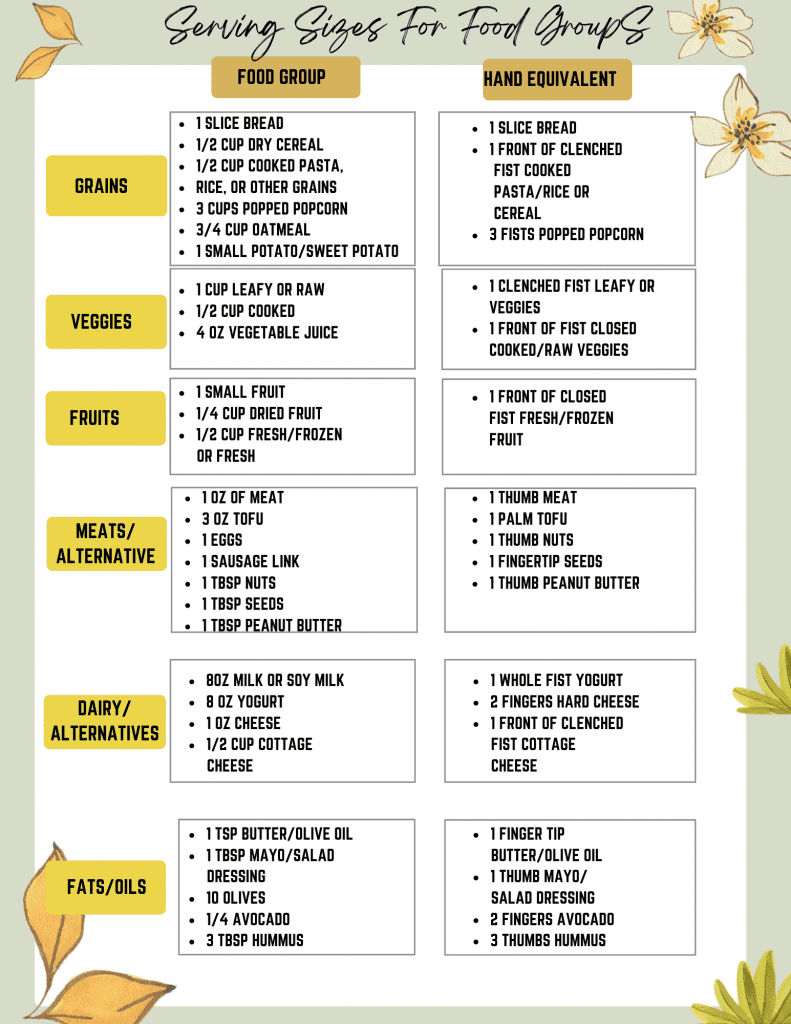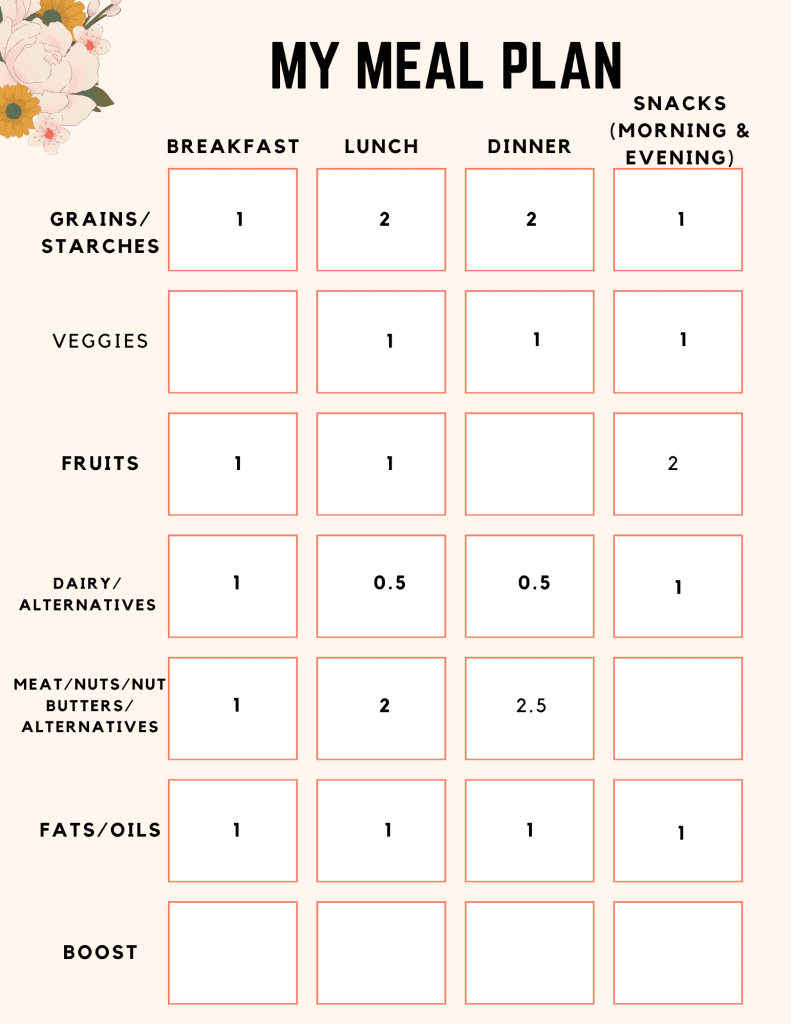Table of Contents
Last updated on May 30th, 2025 at 04:41 pm
Eating disorders are dangerous mental health disorders with numerous medical complexities. Carefully tailored eating disorder recovery meal plans are critical for a safe and lasting recovery from your eating disorder.
If you have had an eating disorder, your hunger cues are not trustworthy. Your body has adapted to survive starvation. A meal plan will help you to retrain your body to tolerate an apporpriate amount of food.
Meal plans in eating disorder recovery include:
- Portion goals for meals and snacks
- Serving size guidelines
- A custom calorie goal (only known to providers)
- A way to track food that does not include calories
If you are in recovery from an eating disorder, you must depend on a medical care team to determine your meal plan. The eating disorder will not allow you do adequately nourish on your own.
This article will explore the goals of a meal plan in recovery, the risks of initiating a meal plan at home, and sample recovery meal plans. These meal plans are appropriate for those struggling with eating disorders such as anorexia, bulimia, orthorexia, and EDNOS.

5 Goals of Eating Disorder Recovery Meal Plans
Structured meal plans in the initial stages of recovery are called mechanical eating plans. They are carefully curated to meet your unique energy needs by a registered dietitian.
Eating disorders, especially those involving very low caloric intake, will require a meal plan carefully constructed by a registered dietitian to re-nourish safely. Eating disorder recovery meal plans will vary from person to person.
5 goals of the recovery meal plan are:
- Weight restore safely
- Normalize eating patterns
- Give your eating disorder voice permission to eat (for example- my dietitian or doctor says I HAVE to eat this much)
- Progressively increase to prevent refeeding syndrome and reduce GI distress
- Establish regular hunger cues
A recovery meal plan will typically start at a lower energy intake and progressively increase. The calorie prescription will include enough energy to account for any necessary overshoot weight if you have lost significant amounts of weight.
What Should I Eat In ED Recovery
A balanced meal plan for eating disorder recovery will consist of:
- Grains and Starches: bread, English muffin, bagel, pita bread, grits, oatmeal, crackers, pretzels, popcorn, quinoa, bulgur, millet, polenta
- Meat or Meat Alternatives: chicken, fish, beef, pork, tofu, beans, tempeh, legumes
- Dairy or dairy alternatives: milk, soy milk, buttermilk, yogurt, cheese, cottage cheese, almond milk
- Vegetables: tomatoes, carrots, kale, broccoli, collard, artichokes, green beans, celery, cucumber, potatoes, winter squash, peas, corn
- Fruit: apricots, bananas, dates, grapes, oranges, juice, melons, strawberries, pineapple, raisins
- Fats and oils: butter, mayo, olive oil, salad dressing, olives, avocado, hummus

The amount of each of these food groups will vary greatly for each person.
All recovery meal plans will include every food group unless there are medical reasons a person can’t have certain foods. If it is deemed appropriate, the healthcare team may support a person in recovery with a vegan recovery meal plan.
Recovery Meal Plan For Anorexia
In your ED recovery, you should plan with the guidance of your healthcare team to begin a with a lower calorie meal plan and gradually add to this plan weekly. Typically, meal plans increase about 500 calories per week.
Here is a meal plan that will be safe to follow for most people.

Recovery Breakfast Portions:
- Grains-1
- Meat/alternatives-1
- Dairy/alternatives-1
- Fruits/Vegetables-1.5
- Fats/Spreads-1
Recovery Lunch Portions:
- Grains-2
- Meat/alternatives-1
- Dairy/alternatives-0.5
- Fruits/Vegetables-1
- Fats/Spreads-1
Recovery After Noon Snack Portions:
- Grains or Cereal Bar-1
Recovery Dinner Portions:
- Grains-2
- Meat/alternatives-2
- Dairy/alternatives-1
- Fruits/Vegetables-1.5
Recovery After Dinner Snack Portions:
- Dairy/Alternative-1
ED Recovery Snacks
There is a difference between meals and snacks in eating disorder recovery.
Meals often include Carbohydrate, fats and proteins. Snacks often include 2 or more of these macronutrient groups.
Examples of good snacks in eating disorder recovery include:
- Apples and peanut butter
- Cheese and crackers
- Rice cakes and nut butters
- Peanut butter and jelly sandwiches
- Tuna and crackers
- Protein balls
- Yogurt and granola
- Smoothie with fruit and protein
- Chips and hummus
- String cheese and carrots
- Lunch meat and veggies
- Celery and peanut butter

Eating Disorder Meal Plan Variations
Rule Of Threes In Eating Disorder Recovery
The rule of threes in eating disorder recovery is a simple way to remind ourselves when and how to nourish.
The rule of threes includes having this structure daily:
- Three meals
- Three snacks
- No more than three hours apart
While individual needs will vary and should be discussed with an eating disorder dietitian, a general eating disorder recovery meal will consist of:
- A grain
- A Fat
- A Protein
- A fruit or veggie

Plate By Plate Method In ED Recovery
The plate approach focuses on the composition of each plate at every meal.
Some individuals can benefit from this approach as it does not require measuring individual portions or calorie counting.
The plate approach includes:
- 1/2 plate of grains/starches
- 1/4 plate veggies/fruits
- 1/4 plate protein
- one fat
- 1 serving of dairy
The plate approach is modified depending on where a person is in recovery.

All In Recovery
All in eating disorder recovery may or may not have a designated meal plan.
All in recovery is focused on:
- Eating as many calories as possible
- Eating as often as possible
- Immediately stopping all eating disorder behaviors
All in eating disorder recovery comes with many risks and it is often unrealistic for people in recovery.

How Do You Start Eating After Starvation
Meal plans typically begin at 1600 calories per day, stepping up 500 calories per week until you reach the target calorie goal prescribed by a dietitian. Target calorie goals for eating disorder recovery typically range from 2400 calories to as much as 6000 calorie per day if a person is experiencing hypermetabolsim.
Steps to stop eating after an eating disorder include:
- Get a meal support team including a dietitian specializing in eating disorders, a doctor and an therapist
- Have support persons prepare and serve meals
- Complete meal plan to 100%
- Delete calorie counting apps and stop counting calories
- Challenge your fear foods
In person or virtual eating disorder treatment is critical as you initiate refeeding.

Risks of Eating Disorder Recovery Plans
While meeting your meal plan is medically necessary and critical for a lasting and full recovery, it can come with risks and discomfort.If you are consuming less than 500 calories a day (the equivalent of a peanut butter and jelly sandwich and a glass of milk) A recovery meal plan at home is not safe.
Extremely low calorie intake leads to starvation syndrome, which requires a higher level of care such as an inpatient facility or medical monitoring at a hospital. Lab values should be monitored as you start to eat again.
Some risk and/or uncomfortable side effects of recovery plans include:
- Gastroparesis
- Refeeding syndrome
- Electrolyte imbalances
- Edema
- Extreme hunger
- Constipation
- Involuntary purging
- Night sweats
- Hypermetabolism
Some of these symptoms of the ED meal plan will not be avoidable. These might include bloating, discomfort, irregular bowel movements, or extreme hunger. However, you can minimize some of these symptoms with self care routines such as heating pads and practicing good bathroom habits.
If you are compulsively exercising, abusing laxatives, or purging your meal plan may need to be adjusted to account for these behaviors and keep you safe.
Tips For ED Recovery
Following a recovery meal plan is not easy emotionally or physically.
These tips for recovery can help:
- Keep a few good recovery books on hand for reference
- If you are Christian, find some bible quotes which align with your recovery
- Keep a playlist of recovery songs for hard days
- Have a list of positive mantras or quotes
- Know the facts and myths about eating disorders
- Get grocery shopping support
- Stop body checking
It is very likely that during the recovery process, nothing will sound good to eat. Eat anyways. You will likely need to follow an eating disorder meal plan until at minimum you have gotten your normal hunger and fullness cues back.
Check out my anorexia story to see some of the strategies I used in my own recovery journey.
- 10 Tips To Cope With Bad Body Image Days - September 29, 2025
- Managing Bloating in Anorexia Recovery - September 15, 2025
- The Orthorexia Quiz: Created by A Dietitian - August 25, 2025